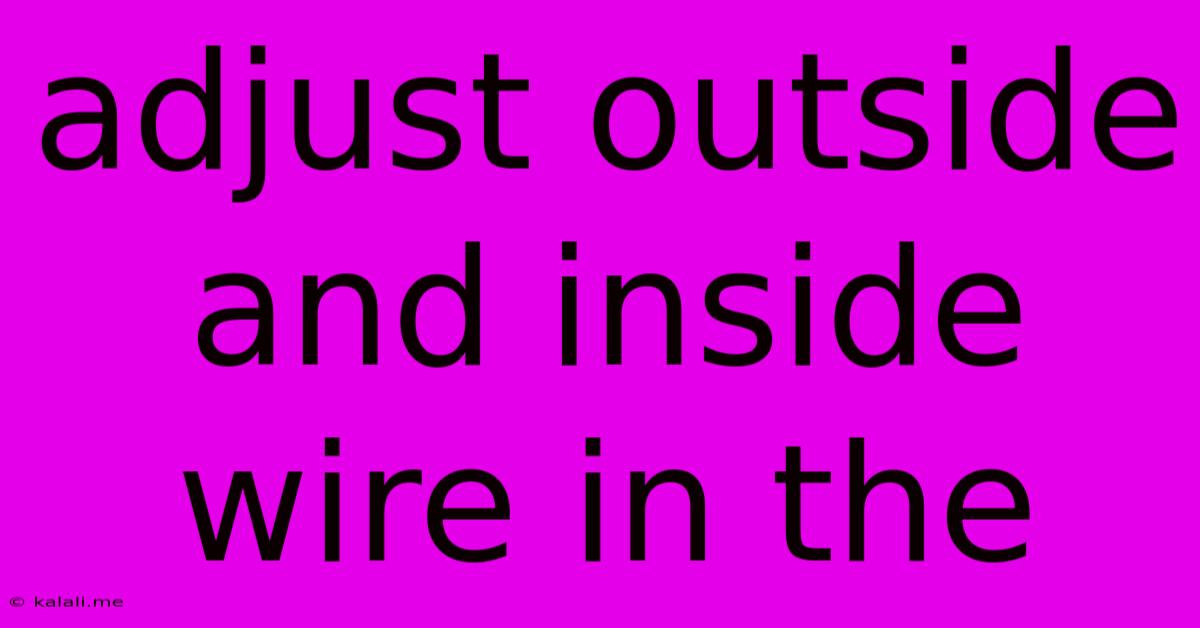Adjust Outside And Inside Wire In The
Kalali
May 23, 2025 · 4 min read

Table of Contents
Adjusting Inside and Outside Wires: A Comprehensive Guide
Meta Description: Learn how to properly adjust inside and outside wires for optimal performance and safety. This guide covers various scenarios, from fixing loose connections to troubleshooting electrical issues.
Wiring, whether inside or outside your home, is crucial for safety and functionality. Loose or improperly adjusted wires can lead to power outages, electrical hazards, and even fires. This comprehensive guide will walk you through the process of adjusting both inside and outside wires, highlighting key considerations and safety precautions. Remember, always prioritize safety and consider consulting a qualified electrician if you are unsure about any step.
Understanding the Differences: Inside vs. Outside Wires
Before we delve into the adjustment process, it's essential to understand the differences between inside and outside wiring. Outside wires, often exposed to the elements, require more robust insulation and weatherproofing. They typically handle higher voltages and are subject to more wear and tear. Inside wires, on the other hand, are generally protected within walls and ceilings, facing less harsh conditions. Different wire gauges and materials are used to account for these differences in environmental exposure and power demands.
Adjusting Inside Wires
Adjusting inside wires typically involves dealing with loose connections or replacing damaged sections. Never attempt to work with live wires. Always turn off the power at the breaker box before commencing any work.
Steps to Adjust Inside Wires:
-
Identify the Problem: Pinpoint the location of the loose connection or damaged wire. Look for exposed wires, frayed insulation, or loose connections at outlets or junction boxes.
-
Turn Off the Power: Switch off the relevant breaker at your electrical panel. Use a voltage tester to double-check that the power is completely off before proceeding.
-
Access the Wiring: Carefully remove the cover plate of the outlet or junction box to expose the wiring.
-
Tighten Loose Connections: If the problem is a loose connection, gently tighten the screws that secure the wires to the terminals. Ensure a firm and secure connection.
-
Replace Damaged Wires: If the wire is damaged, you'll need to cut out the damaged section and splice in a new piece of wire of the same gauge and type. Use wire connectors and electrical tape to ensure a proper and safe connection. This often requires specialized tools and knowledge; if uncertain, consult a professional.
-
Test the Connection: Once the repair is complete, carefully reassemble the outlet or junction box and restore power. Test the connection to ensure it's working correctly.
Adjusting Outside Wires
Adjusting outside wires requires extra caution due to exposure to the elements and potentially higher voltages. Always exercise extreme caution and prioritize safety. If you're uncomfortable working with outdoor wiring, call a qualified electrician.
Steps to Adjust Outside Wires (General Considerations):
-
Assess the Situation: Determine the cause of the problem. This could range from loose connections at a weatherhead to damaged wires due to weather or animal interference.
-
Safety First: Always turn off the power at the breaker box before beginning any work. Use appropriate safety equipment like insulated gloves and tools. Be aware of overhead power lines and maintain a safe distance.
-
Repair or Replacement: Depending on the damage, you may need to tighten loose connections, splice in new wire sections, or even replace entire lengths of wire. Outdoor wire repair often necessitates specialized tools and techniques, often including weatherproofing measures to protect the connections from moisture.
-
Weatherproofing: Proper weatherproofing is crucial for outdoor wiring. Use weatherproof connectors, sealant, and appropriate conduit to protect the wires from moisture and other environmental factors.
-
Inspection: After completing the repair, carefully inspect your work and ensure that all connections are secure and properly weatherproofed.
When to Call a Professional
While some minor adjustments can be tackled with the right knowledge and precautions, it’s crucial to recognize when professional help is necessary. If you are uncomfortable working with electricity, or if the problem is complex or involves high-voltage lines, always call a qualified electrician. Their expertise will ensure safety and a properly functioning electrical system. This is especially important with outdoor wiring given its inherent risks.
This guide provides a general overview. Specific situations may require different approaches. Always prioritize safety and consult a qualified electrician when in doubt. Properly maintained wiring is crucial for both safety and the longevity of your electrical system.
Latest Posts
Latest Posts
-
How To Wire Two Lights To A Single Switch
May 23, 2025
-
3 0 Copper Wire For 200 Amp Service
May 23, 2025
-
What Is A Complete Solution Math
May 23, 2025
-
How To Find The Mean For Coin Toss
May 23, 2025
-
What Is The Color Of Mountain
May 23, 2025
Related Post
Thank you for visiting our website which covers about Adjust Outside And Inside Wire In The . We hope the information provided has been useful to you. Feel free to contact us if you have any questions or need further assistance. See you next time and don't miss to bookmark.